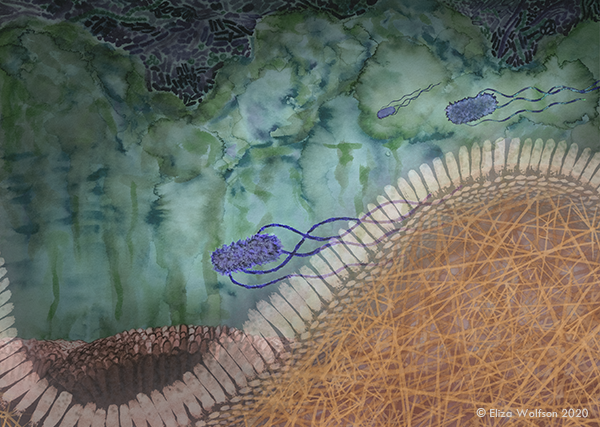Microbiology Editor’s Choice: how do flagella interact with host membranes?
Posted on November 3, 2020 by Microbiology Society
Each month, a manuscript published in our flagship journal Microbiology is chosen by a member of the Editorial Board. This month, the paper is titled ‘The interaction of Escherichia coli O157:H7 and Salmonella Typhimurium flagella with host cell membranes and cytoskeletal components’ and was chosen by Dr Hana Sychrová.
Bacterial pathogens employ various virulence mechanisms to manipulate host cells and establish infections. Their flagella serve not only for cell motility and thereby for host colonisation, but their involvement in a flagella-dependent adherence to host cells has been evidenced. Wolfson, Gally and colleagues show that flagella of two different pathogenic bacteria interact directly with host cell components. A multidisciplinary approach, using sophisticated methods and epithelial cell cultures, revealed an intimate interaction with host cell surfaces and the underlying actin cortex including actin filaments. This interesting finding of flagella interactions with host cell membranes and cytoskeleton, may help to understand mechanisms of prime intimate attachment and invasion of pathogenic bacteria.
The interaction of Escherichia coli O157:H7 and Salmonella Typhimurium flagella with host cell membranes and cytoskeletal components
Bacterial flagella filaments are long, hollow, rotating polymers of flagellin protein that bacteria use to swim to new habitats. In many species, flagella are also involved in initial attachment, but the mechanisms and specific factors involved are not fully understood. This study observed flagella from E. coli O157 and Salmonella Typhimurium crossing host cell boundaries by confocal and electron microscopy, raising the possibility that flagella may interact with and disrupt plasma membranes during attachment. In vitro, flagella rotation played a role in red blood cell haemolysis, polymeric flagellin bound to actin and actin-binding proteins, and enhanced actin polymerisation rates. These flagella interactions likely potentiate Salmonella invasion and intimate attachment of E. coli O157.

We spoke with the co-author Eliza Wolfson to find out more:
What is your institution and how long have you been there?
I am based at the University of Bristol as a visiting postdoctoral researcher, but I'm mostly a freelance scientific illustrator, which I have been doing for the last five years. The work was largely carried out at The Roslin Institute, though, this paper has been a slow burner.
What is your research area?
Bacterial pathogenesis (with a focus on E. coli O157:H7 and Salmonella Typhimurium).
What inspired you to research this topic?
When I learned about type 3 secretion systems and all the murder and mayhem that goes on in and around cells during bacterial infection.
What is the most rewarding part of your research?
When you realise you're thinking about something in completely the wrong way, but the reality is even cooler.
What would you be doing if you weren't a scientist?
I am doing it – I'm a scientific illustrator! I get to draw the pictures that are inside our heads so that people can share their research messages more easily.
Follow Eliza and joint co-author David Gally on Twitter.

